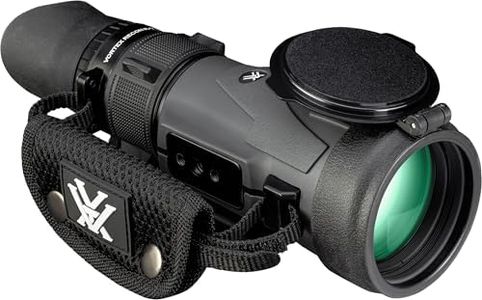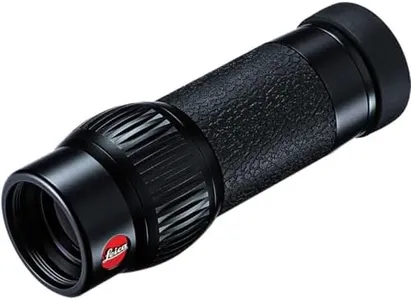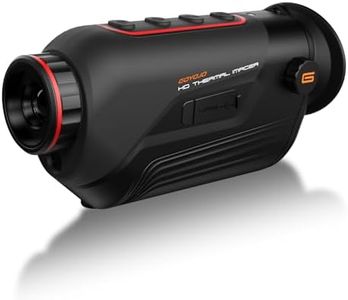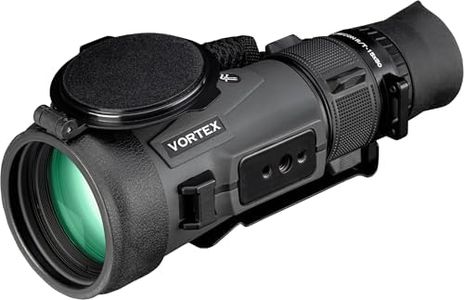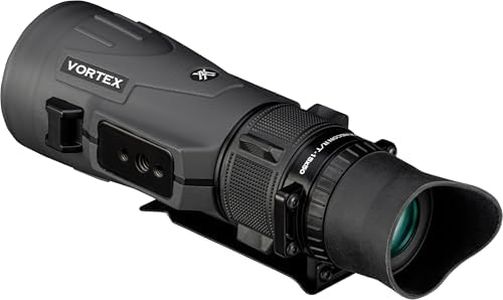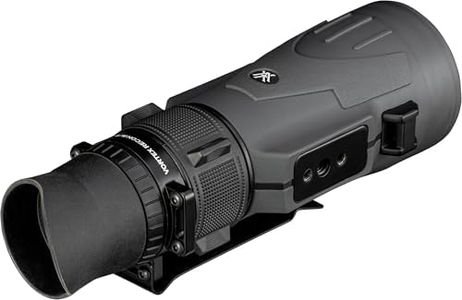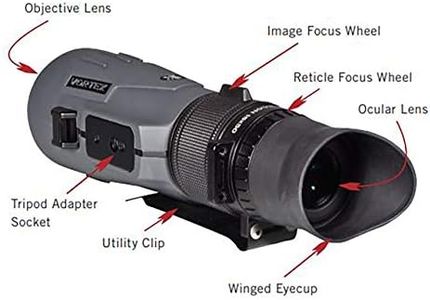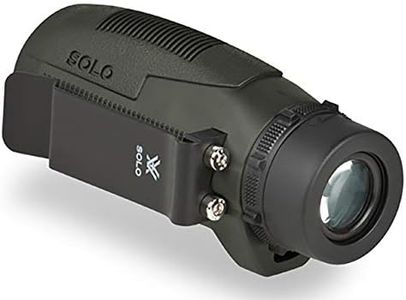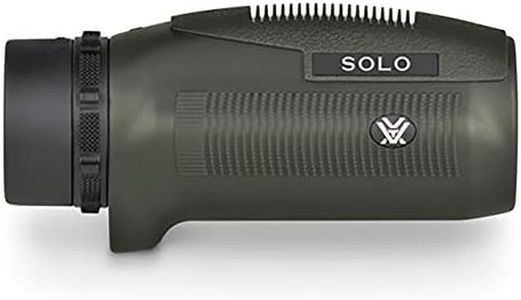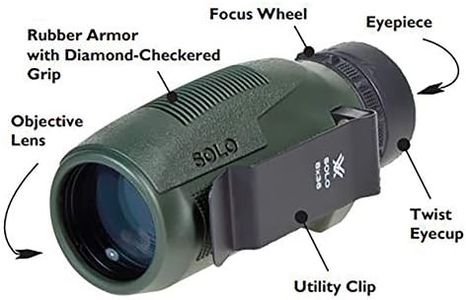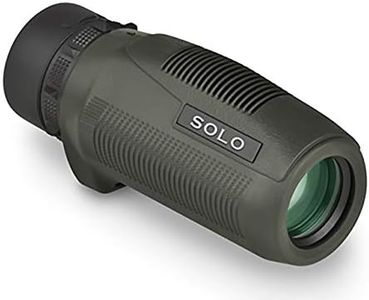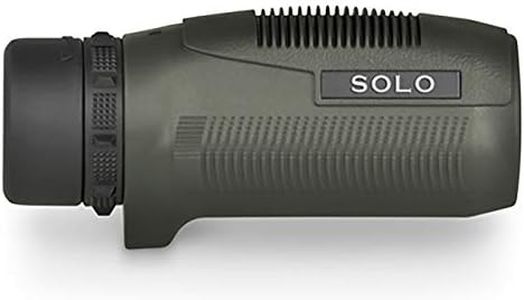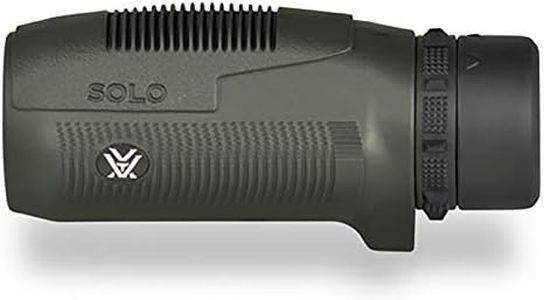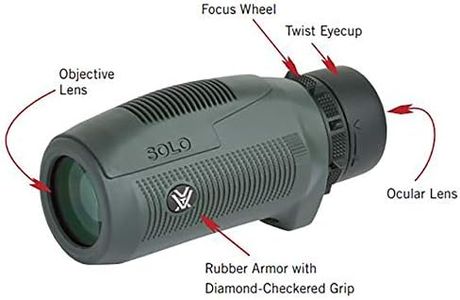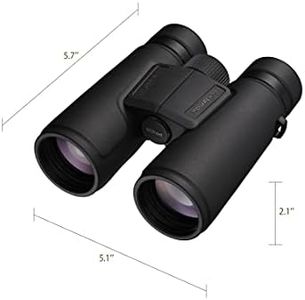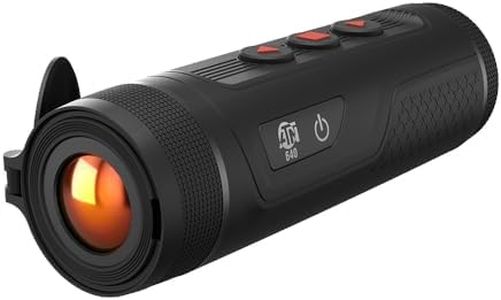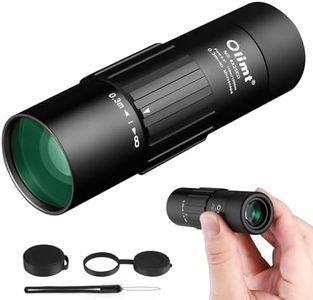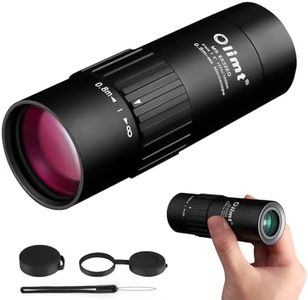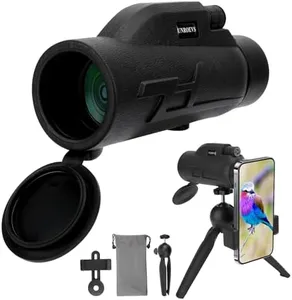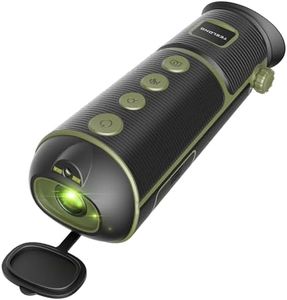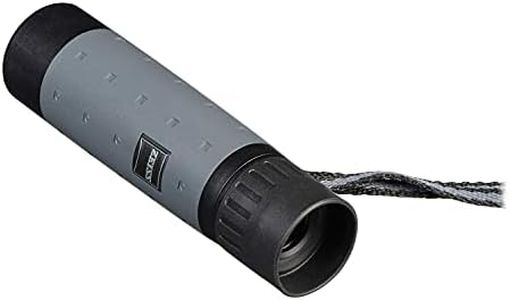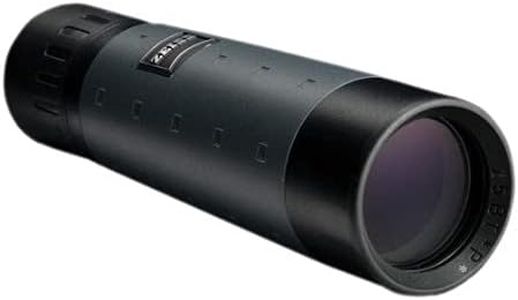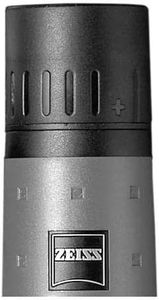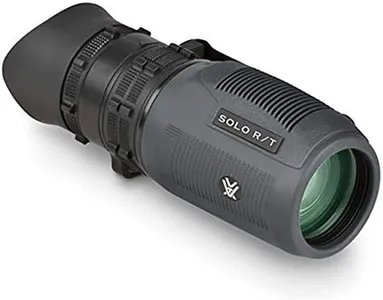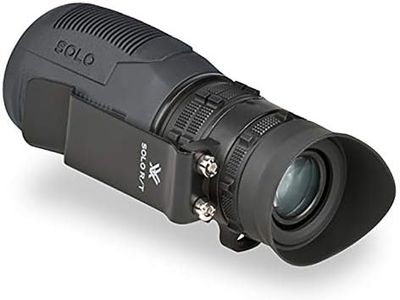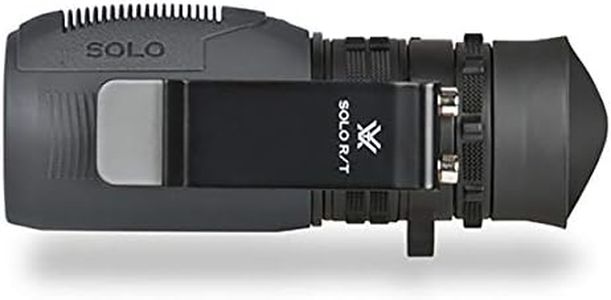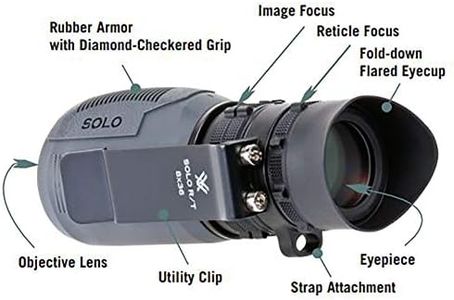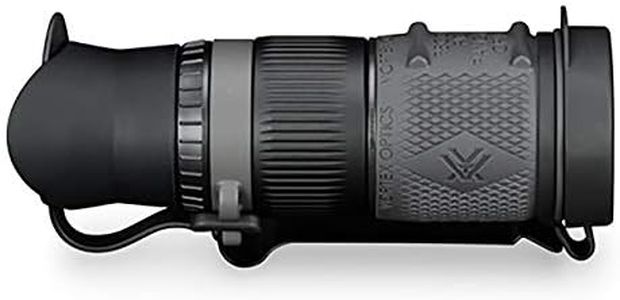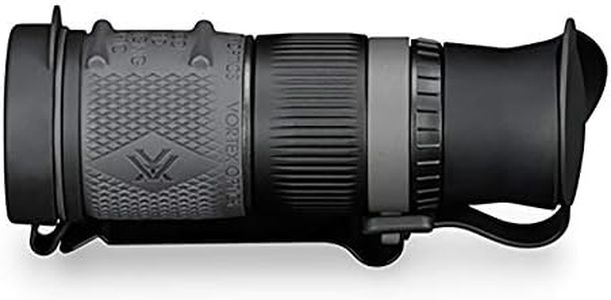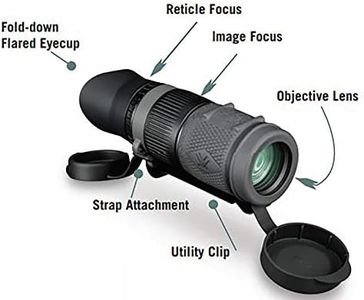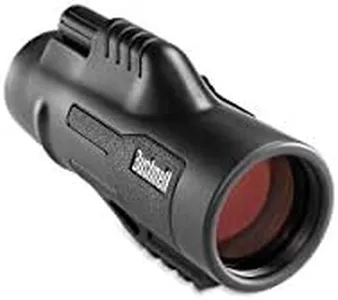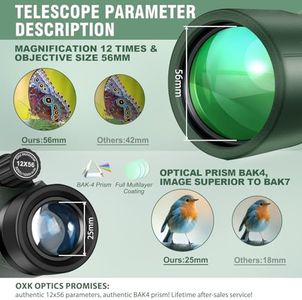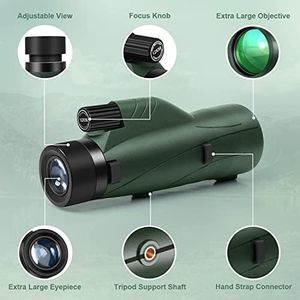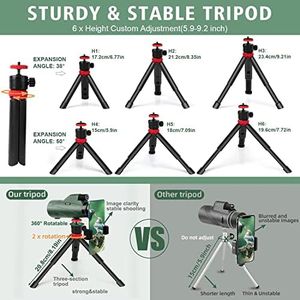10 Best Monoculars 2025 in the United States
Winner
Vortex Optics Recon R/T 15x50 Tactical Scope Monocular - MRAD Reticle, Utility Clip, Adjustable Eyecup, Rubber Armor, Non-Slip Grip, Fogproof, Waterproof - Unlimited, Unconditional Warranty
The Vortex Optics Recon R/T 15x50 monocular is designed for those needing strong, long-range viewing, featuring a fixed 15x magnification and a large 50mm objective lens. This setup helps pick out distant details clearly, making it ideal for activities like hunting and target observation. Its field of view, while not very wide, is sufficient for spotting and range estimation at long distances. The lenses use extra-low dispersion glass and advanced coatings to boost light gathering and reduce glare, enhancing performance in low-light conditions such as dawn or dusk.
Most important from
63 reviews
Vortex Optics Solo Monocular 10x36 - Utility Clip, Adjustable Eyecup, Fully Multi-Coated Lenses, Rubber Armor, Non-Slip Grip, Fogproof, Waterproof - Unlimited, Unconditional Warranty
The Vortex Optics Solo Monocular 10x36 is a compact and lightweight option for anyone looking to enhance their outdoor viewing experience. With 10x magnification and a 36mm objective lens, it excels at providing clear, detailed images in various lighting conditions, thanks to its fully multi-coated lenses that improve light transmission. The rubber armor not only offers a non-slip grip but also adds to its durability against drops and impacts, making it a reliable companion for hiking, birdwatching, or sporting events.
Most important from
5421 reviews
Leica Monovid 8 x 20 Monocular with Leather Case (Black)
The Leica 8x20 Waterproof Monovid Monocular is a compact and well-built device that caters to outdoor enthusiasts, particularly those interested in activities like hunting or nature observation. With an 8x magnification and an objective lens diameter of 20mm, it offers a decent level of detail and clarity for its size. The waterproof feature, along with a nitrogen-filled construction, ensures the monocular performs well in varied weather conditions, preventing fogging and moisture-related issues. The AquaDura lens coating enhances visibility by repelling water and dirt, making it easier to maintain even in rugged environments.
Most important from
94 reviews
Top 10 Best Monoculars 2025 in the United States
Winner
Vortex Optics Recon R/T 15x50 Tactical Scope Monocular - MRAD Reticle, Utility Clip, Adjustable Eyecup, Rubber Armor, Non-Slip Grip, Fogproof, Waterproof - Unlimited, Unconditional Warranty
Vortex Optics Recon R/T 15x50 Tactical Scope Monocular - MRAD Reticle, Utility Clip, Adjustable Eyecup, Rubber Armor, Non-Slip Grip, Fogproof, Waterproof - Unlimited, Unconditional Warranty
Chosen by 1433 this week
Vortex Optics Solo Monocular 10x36 - Utility Clip, Adjustable Eyecup, Fully Multi-Coated Lenses, Rubber Armor, Non-Slip Grip, Fogproof, Waterproof - Unlimited, Unconditional Warranty
Vortex Optics Solo Monocular 10x36 - Utility Clip, Adjustable Eyecup, Fully Multi-Coated Lenses, Rubber Armor, Non-Slip Grip, Fogproof, Waterproof - Unlimited, Unconditional Warranty
Leica Monovid 8 x 20 Monocular with Leather Case (Black)
Leica Monovid 8 x 20 Monocular with Leather Case (Black)
Vortex Optics Solo Monocular 10x25 - Adjustable Eyecup, Fully Multi-Coated Lenses, Rubber Armor, Non-Slip Grip, Fogproof, Waterproof - Unlimited, Unconditional Warranty
Vortex Optics Solo Monocular 10x25 - Adjustable Eyecup, Fully Multi-Coated Lenses, Rubber Armor, Non-Slip Grip, Fogproof, Waterproof - Unlimited, Unconditional Warranty
Nikon Monarch M5 8x42 Binocular | Waterproof, fogproof, Rubber-Armored Binocular with ED Glass, Long Eye Relief | Official Nikon USA Model
Nikon Monarch M5 8x42 Binocular | Waterproof, fogproof, Rubber-Armored Binocular with ED Glass, Long Eye Relief | Official Nikon USA Model
Zeiss 10x25 T* Design Selection Monocular with Pouch
Zeiss 10x25 T* Design Selection Monocular with Pouch
Vortex Optics Solo R/T 8x36 Monocular - MRAD Based Ranging Reticle, Utility Clip, Adjustable Eyecup, Rubber Armor, Non-Slip Grip, Fogproof, Waterproof - Unlimited, Unconditional Warranty
Vortex Optics Solo R/T 8x36 Monocular - MRAD Based Ranging Reticle, Utility Clip, Adjustable Eyecup, Rubber Armor, Non-Slip Grip, Fogproof, Waterproof - Unlimited, Unconditional Warranty
Vortex Optics Recce Pro HD 8x32 Monocular - HD Optical System, MRAD Reticle, Utility Clip, Adjustable Eyecup, Rubber Armor, Non-Slip Grip, Fogproof, Waterproof - Unlimited, Unconditional Warranty
Vortex Optics Recce Pro HD 8x32 Monocular - HD Optical System, MRAD Reticle, Utility Clip, Adjustable Eyecup, Rubber Armor, Non-Slip Grip, Fogproof, Waterproof - Unlimited, Unconditional Warranty
Bushnell Legend 10x42 Ultra HD Monocular, Optical Performance for Hunting and Wildlife Observation
Bushnell Legend 10x42 Ultra HD Monocular, Optical Performance for Hunting and Wildlife Observation
12x56 High Power Monocular Telescope for Adults | Comes with Smartphone Adapter Tripod Travel Bag | Bird Watching Hunting Hiking Camping Gift - Green
12x56 High Power Monocular Telescope for Adults | Comes with Smartphone Adapter Tripod Travel Bag | Bird Watching Hunting Hiking Camping Gift - Green
Our technology thoroughly searches through the online shopping world, reviewing hundreds of sites. We then process and analyze this information, updating in real-time to bring you the latest top-rated products. This way, you always get the best and most current options available.

